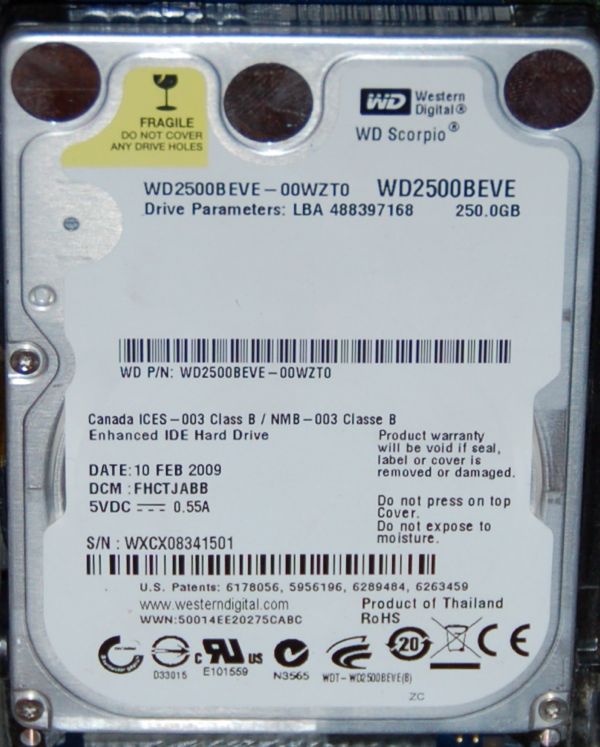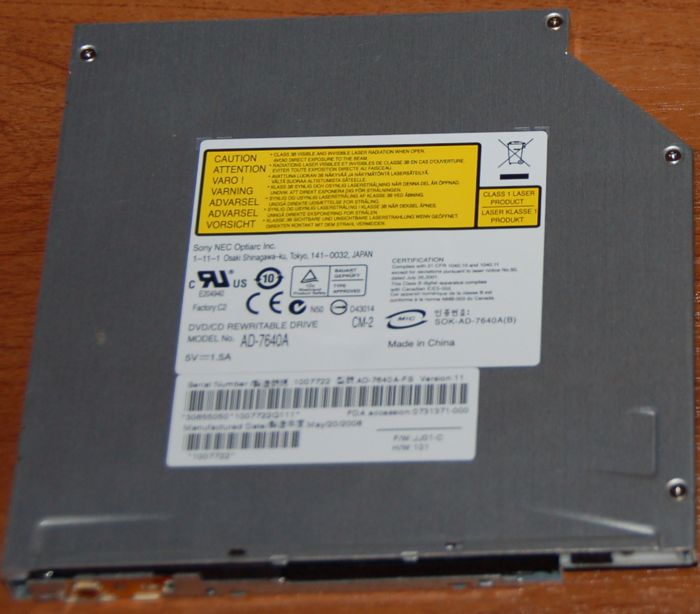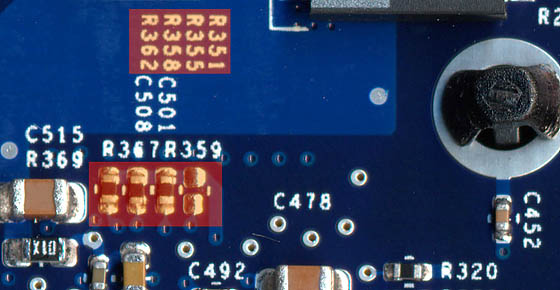Mac mini: we perform an autopsy for organ transplantation :)
Some time ago, on occasion, I purchased a Mac mini on a G4 (PPC) processor: You can

approximately estimate the size by comparing it with a regular computer CD / DVD drive - Mac mini is only a little more.
Standard equipment (produced from July to October 2005):

Decrypt:
CPU: PowerPC G4 1.42GHz
RAM: 512MB DDR
HDD: 80GB 2.5 "PATA
CD / DVD: Combo DVD + CD-RW PATA
Video: Radeon 9200 32MB DDR
Network: 10 / 100Mb Lan Card + 54Mb AirPort (WiFi) + BlueTooth
Ports: USB2.0 + IEEE1394
Turning it in his hands, I decided that it would turn out to be a simple media center (a simple one because 1080p video will not pull, 720p maximum), a file server (to drive torrents, but use the buffer as well), and it’s suitable for browsing the Internet. For these purposes, an 80GB hard drive is completely not enough, the DVD drive does not write blanks (only reads), and Mac OS X often works thoughtfully on 512MB of memory. Therefore, it was decided to upgrade it to the maximum possible. Having rustled through the bins and the Internet, he stopped at the following configuration (what changed is highlighted in bold):
CPU: PowerPC G4 1.58GHz (by overclocking, because the processor is soldered to M.P. and some difficulties arise with replacement :))
RAM : 1024MBDDR (this is the maximum that can be set)
HDD: 250GB 2.5 "PATA + external 500GB USB (internal can be replaced with 320GB or 500GB, but they are already quite expensive, and this one is 250GB much more expensive than its SATA counterparts)
CD / DVD: DVD -RW DL PATA
Video: Radeon 9200 32MB DDR
Network: 10 / 100Mb Lan Card + 54Mb AirPort (WiFi) + BlueTooth
Ports: USB2.0 + IEEE1394
More: memory I took Hynix PC3200 1GB:

Winchester WD2500BEVE 5400rpm:

NEC AD-7640A drive with slot loading:

Let's get started. First of all, we need to open it, which is somewhat nontrivial, since the lid is mounted without a single nail on the internal latches. :) A video on disassembling it in bulk in the Internet, so this process did not take off, you can look at this action here, for example: http://www.youtube.com/watch?v=U2CExAXtnis
Everywhere it is recommended to use a spatula, or even two , but I didn’t have such an instrument at hand, in acceptable condition, so I had to use an ordinary kitchen knife (it should be large but thin). The autopsy itself took no more than 10 seconds.
Replace the memory, hard drive and drive, even to describe to anything, because it changes everything is trite, which even somewhat surprised - I expected great difficulties, having heard the stories of "experienced". :) At this stage, the tool will need only a small Phillips screwdriver. Here's how it all looks (new hard drives and memory have already been installed here, but the drive has been removed):

Well, for the last out of sports interest we’ll disperse this miracle. Here you can’t get by with just one screwdriver, you will also need a soldering iron with a thin sting. We remove the motherboard from the case, unscrewing the bolts in the corners, after removing the memory, drive and hard drive. Then, near the cooler mount on the lower side of M.P., we are looking for this group of resistors:

And solder the resistor number R351. That's it, overclocking is over, we got a frequency of 1.58GHz (there are other combinations by reference). But there is one caveat - the firmware does not know processors with a frequency higher than 1.5GHz and slightly converges it - the processor in the ebout is defined as 750MHz, which does not interfere with anything, with one small but not very pleasant exception - when reinstalling Mac OS X, which has the minimum requirements for an 867MHz processor, either have to remove overclocking, or install a patched distribution, or bypass the restrictions through the command line during installation. I had to use the first option, because I found out about the other two only later.
A small comparison of speed before and after overclocking (benchmark in BOINC):
Before:
Measured floating point speed 903 million ops / sec
Measured integer speed 2759 million ops / sec
After:
Measured floating point speed 1019 million ops / sec
Measured integer speed 3068 million ops / sec
Well, that’s all, I hope someone will be interested and useful. :)
PS In the next series we will break Samsung Q1 Ultra.

approximately estimate the size by comparing it with a regular computer CD / DVD drive - Mac mini is only a little more.
Standard equipment (produced from July to October 2005):

Decrypt:
CPU: PowerPC G4 1.42GHz
RAM: 512MB DDR
HDD: 80GB 2.5 "PATA
CD / DVD: Combo DVD + CD-RW PATA
Video: Radeon 9200 32MB DDR
Network: 10 / 100Mb Lan Card + 54Mb AirPort (WiFi) + BlueTooth
Ports: USB2.0 + IEEE1394
Turning it in his hands, I decided that it would turn out to be a simple media center (a simple one because 1080p video will not pull, 720p maximum), a file server (to drive torrents, but use the buffer as well), and it’s suitable for browsing the Internet. For these purposes, an 80GB hard drive is completely not enough, the DVD drive does not write blanks (only reads), and Mac OS X often works thoughtfully on 512MB of memory. Therefore, it was decided to upgrade it to the maximum possible. Having rustled through the bins and the Internet, he stopped at the following configuration (what changed is highlighted in bold):
CPU: PowerPC G4 1.58GHz (by overclocking, because the processor is soldered to M.P. and some difficulties arise with replacement :))
RAM : 1024MBDDR (this is the maximum that can be set)
HDD: 250GB 2.5 "PATA + external 500GB USB (internal can be replaced with 320GB or 500GB, but they are already quite expensive, and this one is 250GB much more expensive than its SATA counterparts)
CD / DVD: DVD -RW DL PATA
Video: Radeon 9200 32MB DDR
Network: 10 / 100Mb Lan Card + 54Mb AirPort (WiFi) + BlueTooth
Ports: USB2.0 + IEEE1394
More: memory I took Hynix PC3200 1GB:

Winchester WD2500BEVE 5400rpm:

NEC AD-7640A drive with slot loading:

Let's get started. First of all, we need to open it, which is somewhat nontrivial, since the lid is mounted without a single nail on the internal latches. :) A video on disassembling it in bulk in the Internet, so this process did not take off, you can look at this action here, for example: http://www.youtube.com/watch?v=U2CExAXtnis
Everywhere it is recommended to use a spatula, or even two , but I didn’t have such an instrument at hand, in acceptable condition, so I had to use an ordinary kitchen knife (it should be large but thin). The autopsy itself took no more than 10 seconds.
Replace the memory, hard drive and drive, even to describe to anything, because it changes everything is trite, which even somewhat surprised - I expected great difficulties, having heard the stories of "experienced". :) At this stage, the tool will need only a small Phillips screwdriver. Here's how it all looks (new hard drives and memory have already been installed here, but the drive has been removed):

Well, for the last out of sports interest we’ll disperse this miracle. Here you can’t get by with just one screwdriver, you will also need a soldering iron with a thin sting. We remove the motherboard from the case, unscrewing the bolts in the corners, after removing the memory, drive and hard drive. Then, near the cooler mount on the lower side of M.P., we are looking for this group of resistors:

And solder the resistor number R351. That's it, overclocking is over, we got a frequency of 1.58GHz (there are other combinations by reference). But there is one caveat - the firmware does not know processors with a frequency higher than 1.5GHz and slightly converges it - the processor in the ebout is defined as 750MHz, which does not interfere with anything, with one small but not very pleasant exception - when reinstalling Mac OS X, which has the minimum requirements for an 867MHz processor, either have to remove overclocking, or install a patched distribution, or bypass the restrictions through the command line during installation. I had to use the first option, because I found out about the other two only later.
A small comparison of speed before and after overclocking (benchmark in BOINC):
Before:
Measured floating point speed 903 million ops / sec
Measured integer speed 2759 million ops / sec
After:
Measured floating point speed 1019 million ops / sec
Measured integer speed 3068 million ops / sec
Well, that’s all, I hope someone will be interested and useful. :)
PS In the next series we will break Samsung Q1 Ultra.
